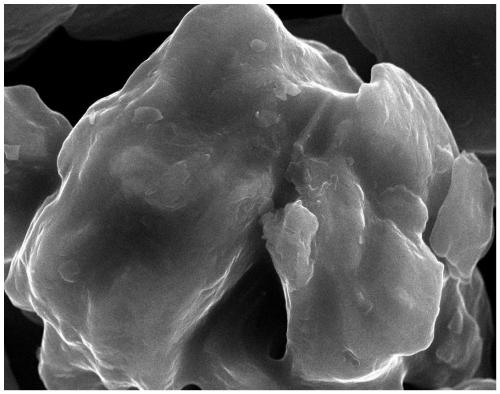High-capacity fast-charging type microcrystal graphite negative electrode material and preparation method thereof
A technology of anode material and microcrystalline graphite, which is applied in the field of high-capacity fast-charge lithium-ion battery anode materials and its preparation, can solve the problem that the capacity is difficult to meet electric vehicles, etc., and achieve a significant increase in capacity and good catalytic uniformity.
- Summary
- Abstract
- Description
- Claims
- Application Information
AI Technical Summary
Problems solved by technology
Method used
Image
Examples
Embodiment 1
[0037] (1) Mix 3 μm elemental silicon and polypropylene evenly at a mass ratio of 1:0.5, heat to 150°C while stirring under a nitrogen atmosphere, stir for 3 hours, and cool the catalyst / pore-forming agent composite.
[0038] (2) Mix 8 μm microcrystalline graphite with catalyst / pore-forming agent compound and petroleum pitch according to the ratio of 10:1:0.8 to form a mixture.
[0039] (3) Isostatic pressing: the mixture is placed in a rubber mold, subjected to isostatic pressing at a pressure of 200 MPa, and kept for 1.5 hours to obtain an isostatic pressed block.
[0040] (4) Carbonization: Under a nitrogen atmosphere, the isostatically pressed block was heated to 750°C at a heating rate of 1°C / min, and a carbon block containing micron-sized pores was obtained after natural cooling.
[0041] (5) Catalytic graphitization: Put the carbon block containing micron-sized pores into a conventional Acheson furnace for catalytic graphitization to obtain a graphitized block.
[0042...
Embodiment 2
[0044] (1) Mix 3 μm elemental silicon and polyethylene evenly at a mass ratio of 1:1, heat to 120°C while stirring under a nitrogen atmosphere, stir for 2 hours, and cool the catalyst / pore-forming agent composite.
[0045] (2) Mix 8 μm microcrystalline graphite with catalyst / pore-forming agent compound and petroleum pitch according to the ratio of 10:0.7:1.1.
[0046] (3) Isostatic pressing: put the mixture in a rubber mold, and perform isostatic pressing under a pressure of 250 MPa, and hold the pressure for 3 hours.
[0047] (4) Carbonization: Under a nitrogen atmosphere, the isostatically pressed block material was heated to 800°C at a heating rate of 0.5°C / min, and a carbon block containing micron-sized pores was obtained after natural cooling.
[0048] (5) Catalytic graphitization: Catalytic graphitization is carried out in a conventional Acheson furnace, and the maximum temperature of graphitization is 3000-3400°C.
[0049] (6) Finally, the graphitized block material wa...
Embodiment 3
[0051] (1) Mix 5 μm silicon carbide and polystyrene evenly at a mass ratio of 1:0.5, heat to 150°C while stirring under a nitrogen atmosphere, stir for 3 hours, and cool the catalyst / pore-forming agent composite.
[0052] (2) Mix 8 μm microcrystalline graphite with catalyst / pore former compound and petroleum pitch according to the ratio of 10:1:0.8.
[0053] (3) Isostatic pressing: place the mixture in a rubber mold, and treat it under isostatic pressure at 200 MPa, and hold the pressure for 1.5 hours.
[0054] (4) Carbonization: Under an argon atmosphere, the isostatically pressed block was heated to 750°C at a heating rate of 1°C / min, and a carbon block containing micron-sized pores was obtained after natural cooling.
[0055] (5) Catalytic graphitization: Catalytic graphitization is carried out in a conventional Acheson furnace.
[0056] (6) Finally, the graphitized block material was crushed, shaped, classified, demagnetized, and sieved to obtain the 3# sample.
PUM
 Login to View More
Login to View More Abstract
Description
Claims
Application Information
 Login to View More
Login to View More - R&D
- Intellectual Property
- Life Sciences
- Materials
- Tech Scout
- Unparalleled Data Quality
- Higher Quality Content
- 60% Fewer Hallucinations
Browse by: Latest US Patents, China's latest patents, Technical Efficacy Thesaurus, Application Domain, Technology Topic, Popular Technical Reports.
© 2025 PatSnap. All rights reserved.Legal|Privacy policy|Modern Slavery Act Transparency Statement|Sitemap|About US| Contact US: help@patsnap.com



